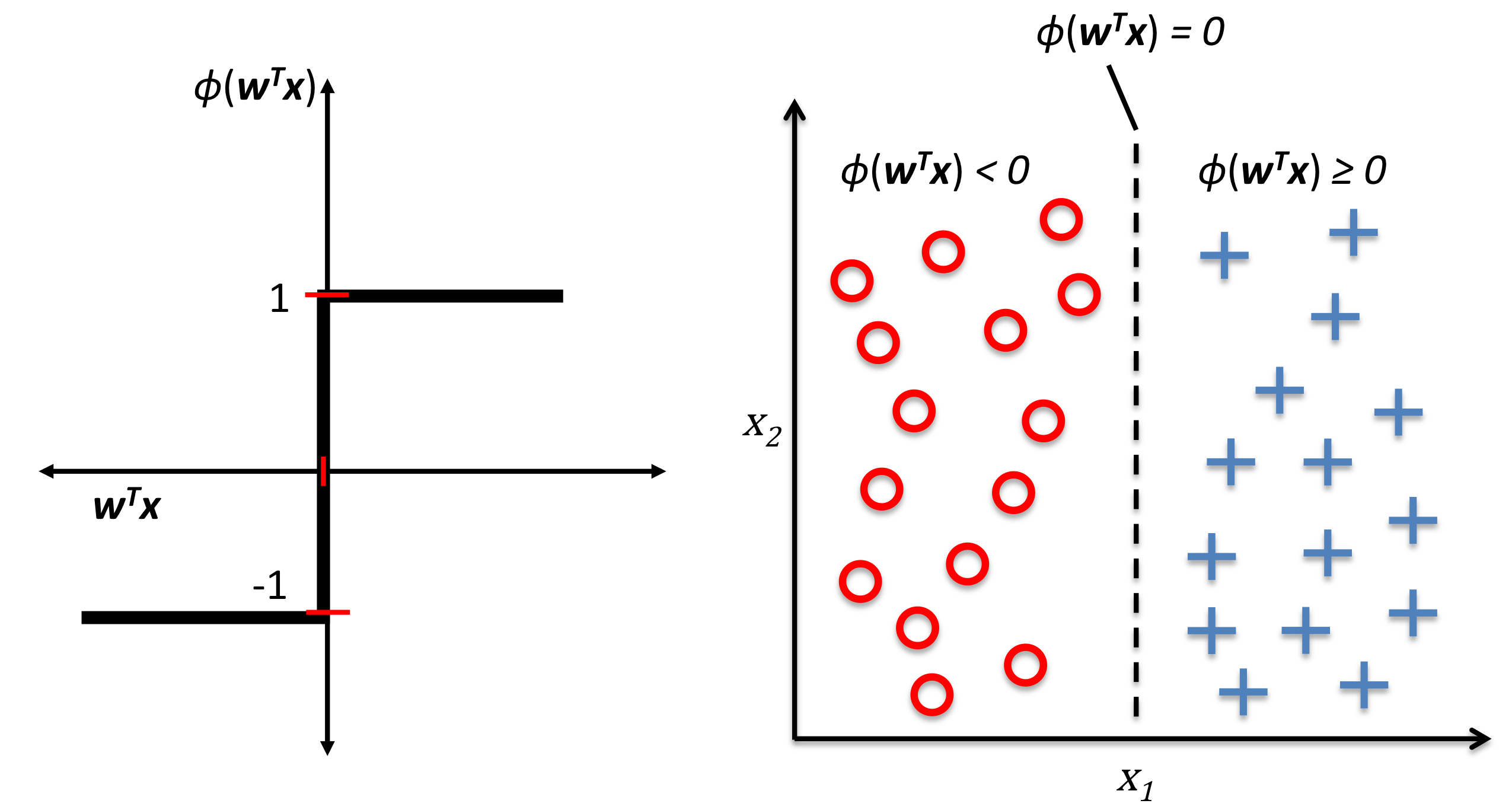

感知器算法主要是二值分类问题,以上的图为感知器的原理,通过感知器将线性可分的两个类别区分开来。
以下是感知器算法的Python代码实现:
import numpy as np class Perceptron(object): """Perceptron classifier. Parameters ------------ eta:float Learning rate (between 0.0 and 1.0) n_iter:int Passes over the training dataset. Attributes ------------- w_: 1d-array Weights after fitting. errors_: list Numebr of misclassifications in every epoch. """ def __init__(self, eta=0.01, n_iter=10): self.eta = eta self.n_iter = n_iter def fit(self, X, y): """Fit training data. Parameters ------------ X: {array-like}, shape=[n_samples, n_features] Training vectors, where n_samples is the number of samples and n_featuers is the number of features. y: array-like, shape=[n_smaples] Target values. Returns ---------- self: object """ self.w_ = np.zeros(1 + X.shape[1]) # Add w_0 self.errors_ = [] for _ in range(self.n_iter): errors = 0 for xi, target in zip(X, y): update = self.eta * (target - self.predict(xi)) self.w_[1:] += update * xi self.w_[0] += update errors += int(update != 0.0) self.errors_.append(errors) return self def net_input(self, X): """Calculate net input""" return np.dot(X, self.w_[1:]) + self.w_[0] def predict(self, X): """Return class label after unit step""" return np.where(self.net_input(X) >= 0.0, 1, -1) #analoge ? : in C++
以下一个感知器算法的实践:
#coding:utf-8 #**********************************https://ljalphabeta.gitbooks.io/python-/content/ch2section3.html #pərˈsepträn import matplotlib.pyplot as plt import numpy as np import pandas as pd from matplotlib.colors import ListedColormap import Perceptron as perceptron_class df = pd.read_csv('https://archive.ics.uci.edu/ml/machine-learning-databases/iris/iris.data', header=None) #print df.tail() #抽取出前100条样本,这正好是Setosa和Versicolor对应的样本,我们将Versicolor对应的数据作为类别1,Setosa对应的作为-1。 # 对于特征,我们抽取出sepal length和petal length两维度特征,然后用散点图对数据进行可视化 y = df.iloc[0:100, 4].values y = np.where(y == 'Iris-setosa', -1, 1) X = df.iloc[0:100, [0, 2]].values # plt.scatter(X[:50, 0], X[:50, 1],color='red', marker='o', label='setosa') # plt.scatter(X[50:100, 0], X[50:100, 1],color='blue', marker='x', label='versicolor') # plt.xlabel('sepal length') # plt.ylabel('petal length') # plt.legend(loc='upper left') # plt.show() #这里是对于感知机模型进行训练 ppn = perceptron_class.Perceptron(eta=0.1, n_iter=10) ppn.fit(X, y) #画出分界线 def plot_decision_regions(X, y, classifier, resolution=0.02): # setup marker generator and color map markers = ('s', 'x', 'o', '^', 'v') colors = ('red', 'blue', 'lightgreen', 'gray', 'cyan') cmap = ListedColormap(colors[:len(np.unique(y))]) # plot the decision surface x1_min, x1_max = X[:, 0].min() - 1, X[:, 0].max() + 1 x2_min, x2_max = X[:, 1].min() - 1, X[:, 1].max() + 1 xx1, xx2 = np.meshgrid(np.arange(x1_min, x1_max, resolution), np.arange(x2_min, x2_max, resolution)) Z = classifier.predict(np.array([xx1.ravel(), xx2.ravel()]).T) Z = Z.reshape(xx1.shape) print(xx1) plt.contourf(xx1, xx2, Z, alpha=0.4, cmap=cmap) plt.xlim(xx1.min(), xx1.max()) plt.ylim(xx2.min(), xx2.max()) # plot class samples for idx, cl in enumerate(np.unique(y)): plt.scatter(x=X[y == cl, 0], y=X[y == cl, 1], alpha=0.8, c=cmap(idx), marker=markers[idx], label=cl) plot_decision_regions(X, y, classifier=ppn) plt.xlabel('sepal length [cm]') plt.ylabel('petal length [cm]') plt.legend(loc='upper left') plt.show()ps:文中的图片和代码主要来源网络以及Sebastian Raschka所著的PYTHON MACHINE LEARNING
























 4632
4632

 被折叠的 条评论
为什么被折叠?
被折叠的 条评论
为什么被折叠?








